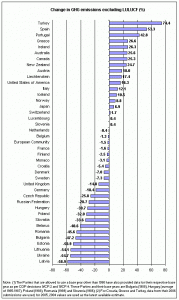
In this section, you will learn how three countries with expanding economies have reduced their GHG emissions:
![]() Click a topic to jump to a page with details.
Click a topic to jump to a page with details.
Canada ratified the Kyoto Protocol on Dec. 17, 2002 by act of parliament. We were therefore bound by our own law to reduce our greenhouse gas emissions to 6% below our 1990 levels before 2012. However, in May 2006, the Canadian Environment Minister declared that the Government of Canada no longer endorses or promotes the Kyoto Protocol emission targets saying they are too ambitious. (1)
Are there any developed countries that are successfully reducing their GHGs?
Figure 1 (2) shows the change in greenhouse gas (GHG) emissions (excluding LULUCF*) for UNFCCC Annex 1 countries from 1990 to 2005. These are developed countries, like Canada, that should be meeting their Kyoto targets.
Many of the countries that have reduced their GHGs are eastern European. Their reductions have largely been due to the collapse of their economies after the disintegration of the Soviet Union.
But some countries (including the three above) reduced their GHG emissions as they grew their Gross Domestic Product (GDP) (i.e. got wealthier):
| Country | 1990 GDP (BN$US)(3) | 2005 GDP (BN$US)(3) | % Chg | 1990 GHG (Mt CO2e)(4) | 2005 GHG (Mt CO2e)(4) | % Chg |
|---|---|---|---|---|---|---|
| UK | 991.1 | 2,226.3 | +124.6% | 776.1 | 657.4 | -15.3% |
| Germany | 1,714.4 | 2,786.9 | +62.6% | 1,226.3 | 1,001.5 | -18.3% |
| Sweden | 242.2 | 357.4 | +47.6% | 72.2 | 67.0 | -7.2% |
| Canada | 582.7 | 1,131.8 | +94.2% | 598.9 | 746.9 | +24.7% |
* LULUCF – Land Use, Land Use Changes, and Forestry





